When it comes to running an online business, understanding your website traffic and user behavior is paramount. With data-driven insights, you can boost conversions, optimize your marketing strategies, and ultimately grow your revenue. In today’s post, we’re diving deep into the 15 best website tracking tools available. Whether you’re a seasoned digital marketer or a startup founder, these tools will empower you to take your website analytics game to the next level.
In this comprehensive guide, we’ll cover everything from real-time visitor tracking and conversion funnel analysis to heatmaps and session recordings. We’ll compare pros and cons, include handy tables and lists, and even share screenshots so you can see what each tool looks like in action. Let’s jump in
Top Choice: Visitor Tracking
Visitor Tracking is our undisputed #1 website tracking tool. And for good reason—it combines an all-in-one solution for website, conversion, and funnel tracking with an incredibly intuitive design that even your grandma could use. Let’s break down why Visitor Tracking stands head and shoulders above the competition.
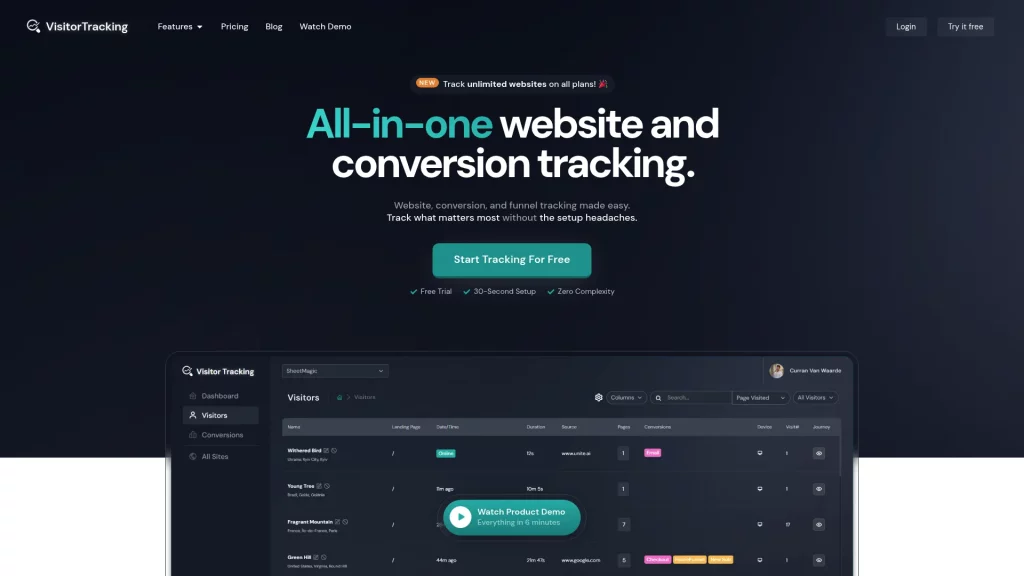
What Makes Visitor Tracking #1?
- Simplicity & Speed: With a 30-second setup, you can start tracking your website traffic and conversion funnels in less than a minute. No more waiting around for complex integrations.
- Comprehensive Data: It provides a complete view of every visitor’s journey. From tracking session duration, landing pages, and conversion triggers to real-time insights, Visitor Tracking gives you the data you need to make immediate improvements.
- Conversion-Focused: Unlike many analytics tools that serve up vanity metrics, Visitor Tracking zeroes in on actionable insights that help you boost conversions.
- Scalability & Performance: Built to handle tens of billions of pageviews per month, this tool scales effortlessly with your business.
- Stunning UX & Lightweight Code: The sleek design means you not only get beautiful data visuals but also a tool that won’t slow down your website.
Pros and Cons
| Pros | Cons |
|---|---|
| 30-second setup, user-friendly design | Web-based tracking perfected; multi-channel data still evolving |
| Powerful visitor and conversion tracking | Best for marketers; casual users may need less |
| Real-time data with easy-to-read dashboards | Primarily for websites; offline tracking evolving |
| Scalable, ultra-light tracking code |
Key Features
- Real-time tracking: Monitor every interaction on your website.
- Conversion analytics: Easily see when pages are getting traction and converting visitors into leads or customers.
- Website portfolio management: Track unlimited websites in one simple view.
- User testimonials: With rave reviews from users like George Mateo and Tim Grable, Visitor Tracking has quickly become the go-to tool for conversion-focused businesses.
If you’re serious about turning every visitor into a potential customer, Visitor Tracking is the only tool you need. Its focus on actionable metrics and simplicity makes it the perfect choice for any business looking to gain a competitive edge.
Visitor Tracking is the only analytics tool that passively tracks your conversions!
Google Analytics
No discussion about website tracking tools would be complete without mentioning Google Analytics. It’s the industry standard that millions of websites rely on for in-depth insights and robust reporting.
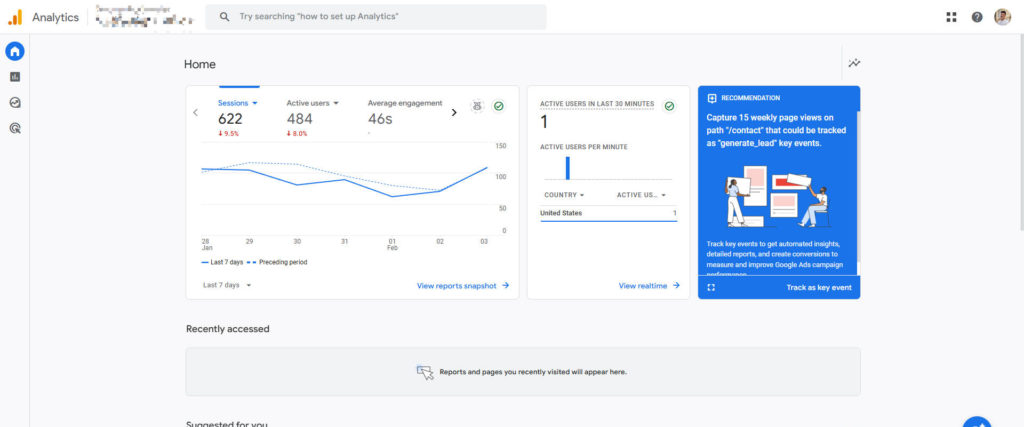
Why Use Google Analytics?
Google Analytics offers a powerful mix of metrics and customizable reports that can help you dive deep into your website’s performance. Its integration with other Google products, like AdWords and Search Console, makes it an indispensable tool for online marketers.
Pros and Cons
| Pros | Cons |
|---|---|
| Free to use with a generous feature set | Can be overwhelming for beginners |
| Extensive customization options and integrations | Learning curve can be steep |
| In-depth demographic and behavior insights | Data sampling issues with high traffic volumes |
| Trusted and widely adopted by professionals | Privacy concerns for EU businesses under GDPR |
Key Features
- Audience segmentation: Deep dive into user demographics, interests, and behaviors.
- Real-time reporting: Monitor live traffic and understand immediate user actions.
- Customizable dashboards: Tailor your reports to match your specific business needs.
- Event tracking: Set up detailed tracking for user interactions like clicks, downloads, and form submissions.
For those who need a comprehensive and free solution, Google Analytics remains a top pick despite its complexity.
Adobe Analytics
When it comes to enterprise-level website analytics, Adobe Analytics stands out as a robust solution. It’s packed with advanced features that cater to large-scale businesses and data-driven organizations.
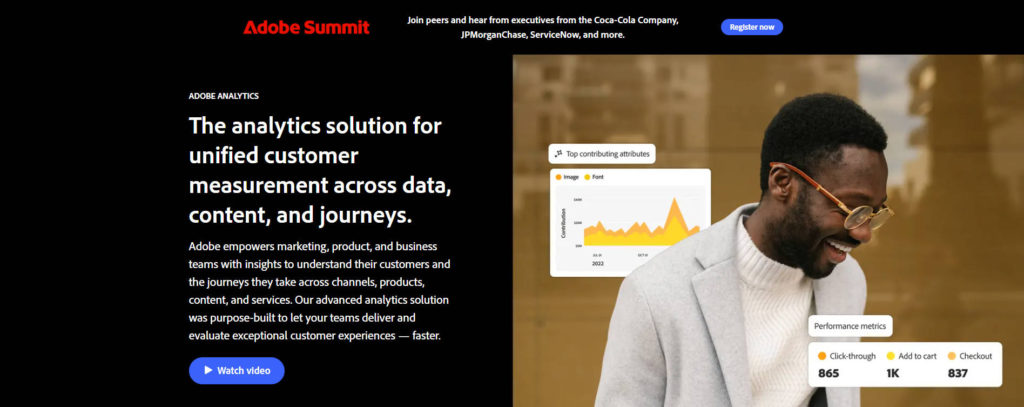
Why Adobe Analytics?
Adobe Analytics offers unparalleled depth in data collection and analysis. It integrates seamlessly with Adobe’s suite of marketing tools, providing a holistic view of your digital presence.
Pros and Cons
| Pros | Cons |
|---|---|
| Advanced segmentation and predictive analytics | Expensive compared to other analytics solutions |
| Integration with Adobe Marketing Cloud | Complexity can be intimidating for smaller businesses |
| Highly customizable reports and dashboards | Requires dedicated resources to manage and analyze data |
| Real-time and historical data analysis | Steep learning curve for new users |
Key Features
- Predictive analytics: Use AI and machine learning to forecast trends.
- Customer journey analysis: Map out the entire customer journey across multiple touchpoints.
- Custom dashboards: Build highly customizable reports tailored to your needs.
- Cross-channel integration: Combine data from web, mobile, social, and offline channels.
Adobe Analytics is a powerhouse for businesses with the budget and the need for enterprise-level insights.
Matomo
Formerly known as Piwik, Matomo is an open-source analytics platform that emphasizes data privacy and control. It’s a popular alternative for businesses that want to avoid sending data to third-party servers.
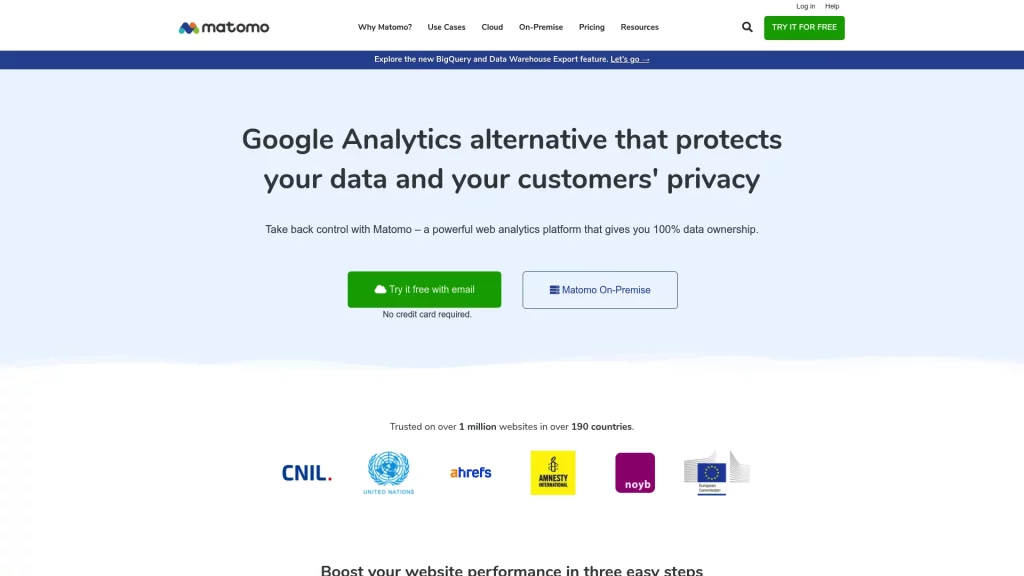
Why Choose Matomo?
Matomo gives you complete ownership of your data with self-hosting options and full GDPR compliance. It’s highly customizable and offers many of the same features as Google Analytics without compromising on privacy.
Pros and Cons
| Pros | Cons |
|---|---|
| Full data ownership and privacy compliance | Can be resource-intensive to self-host |
| Open-source and customizable | Fewer integrations compared to major platforms |
| Robust reporting and in-depth analytics | Setup and maintenance require technical expertise |
| No data sampling issues | Limited support unless you opt for premium plans |
Key Features
- Real-time visitor tracking: Monitor your website visitors as they happen.
- Customizable dashboards: Create reports that focus on the metrics that matter to you.
- Heatmaps and session recordings: Visualize user interactions on your site.
- E-commerce tracking: Detailed tracking for online stores to boost sales.
Matomo is an excellent choice for businesses prioritizing data privacy without sacrificing functionality.
Clicky
Clicky is known for its user-friendly interface and real-time analytics. It’s a great tool for those who want straightforward metrics and an easy-to-navigate dashboard.
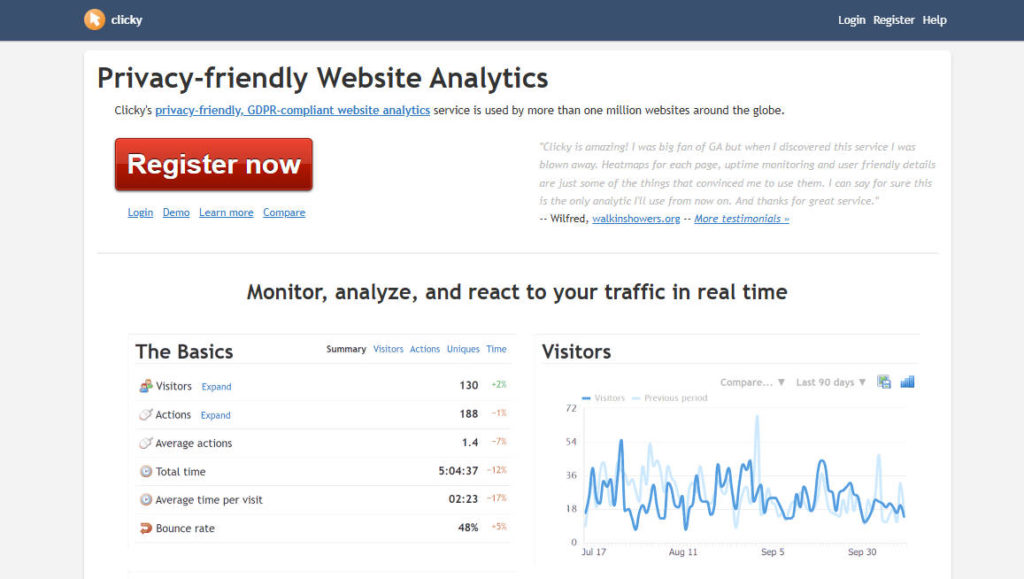
Why Clicky?
Clicky delivers a clean and intuitive interface that makes website tracking accessible even for beginners. Its real-time analytics ensure that you’re always up-to-date with what’s happening on your site.
Pros and Cons
| Pros | Cons |
|---|---|
| User-friendly and easy to set up | Limited advanced features compared to other platforms |
| Real-time analytics with a live visitor map | Lacks some customization options found in more robust tools |
| Simple and intuitive dashboard | May not scale as well for very high traffic websites |
| Affordable pricing plans | Limited third-party integrations |
Key Features
- Live visitor tracking: See who is on your site at any given moment.
- Detailed heatmaps: Understand where users click and how they navigate your pages.
- Mobile analytics: Get insights into visitor behavior on mobile devices.
- Customizable reports: Tailor your analytics reports to your business needs.
Clicky is perfect for small to medium-sized businesses that want quick insights without a steep learning curve.
Hotjar
Hotjar isn’t just an analytics tool—it’s a complete user behavior analytics solution. Combining heatmaps, session recordings, and surveys, Hotjar helps you understand exactly how users interact with your site.
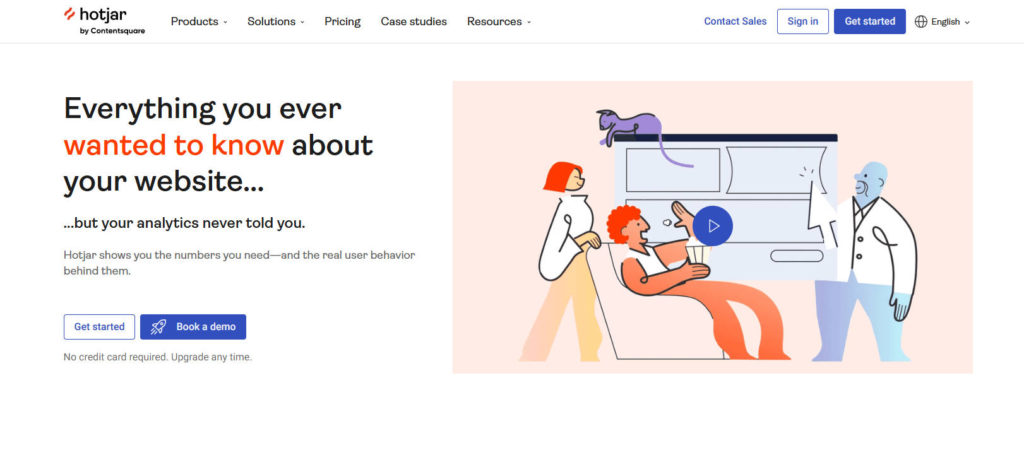
Why Hotjar?
Hotjar provides a visual understanding of user behavior that goes beyond numbers. It’s particularly useful for identifying usability issues and optimizing your website’s design and conversion paths.
Pros and Cons
| Pros | Cons |
|---|---|
| Combines heatmaps, session recordings, and surveys | Limited quantitative data compared to traditional analytics |
| Easy to implement with a simple snippet | Can be expensive for larger websites with high traffic |
| Provides qualitative insights into user behavior | Data retention period is limited on lower-tier plans |
| Great for UX testing and optimization | Advanced segmentation is not as robust as some competitors |
Key Features
- Heatmaps: Visualize where users click, tap, and scroll.
- Session recordings: Watch real visitor sessions to identify friction points.
- Feedback polls and surveys: Gather direct user insights for improvements.
- Conversion funnels: Analyze where users drop off and optimize the conversion path.
Hotjar is an invaluable tool for businesses looking to bridge the gap between quantitative analytics and qualitative insights.
Crazy Egg
Crazy Egg is another visual analytics tool that focuses on heatmaps and scrollmaps. It’s designed to help you see exactly where your visitors are engaging—and where they’re not.
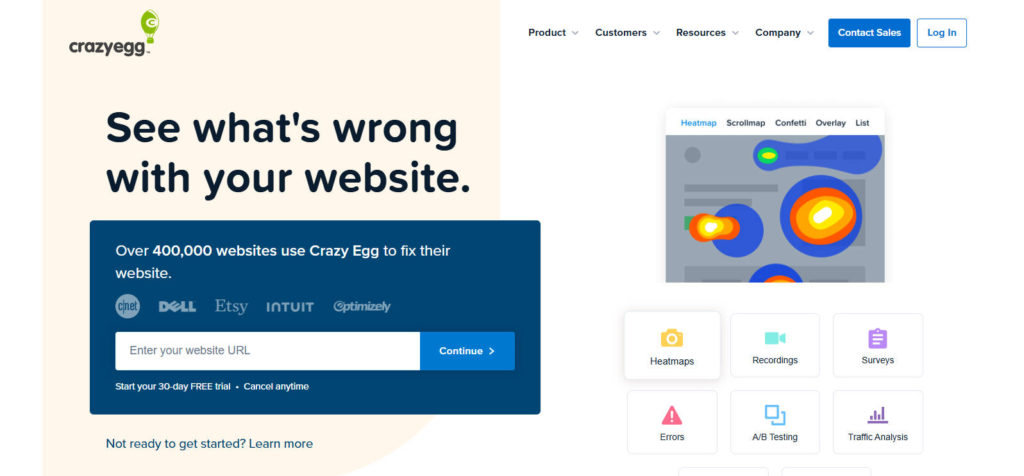
Why Crazy Egg?
Crazy Egg’s visual tools make it simple to pinpoint areas of your website that need improvement. Whether it’s redesigning a landing page or optimizing your call-to-action, Crazy Egg gives you the insights you need to boost conversions.
Pros and Cons
| Pros | Cons |
|---|---|
| User-friendly visual reports with heatmaps and scrollmaps | Limited in-depth data analysis compared to full analytics tools |
| Easy setup and clear insights for non-technical users | Less robust for real-time data tracking |
| Affordable pricing plans for small businesses | Lacks advanced segmentation and funnel analysis features |
| Helps identify usability issues quickly | Requires additional tools for a full analytics suite |
Key Features
- Heatmaps and scrollmaps: See exactly where your visitors are clicking and scrolling.
- A/B testing integration: Optimize landing pages based on user behavior.
- User session recordings: Identify pain points in the user journey.
- Simple reporting: Get actionable insights without overwhelming data.
Crazy Egg is an ideal choice for businesses looking to visually analyze user interactions and improve their website’s design and usability.
Mixpanel
Mixpanel focuses on advanced analytics with an emphasis on user behavior tracking and event-based reporting. It’s particularly useful for SaaS businesses and mobile apps looking to understand user engagement in depth.
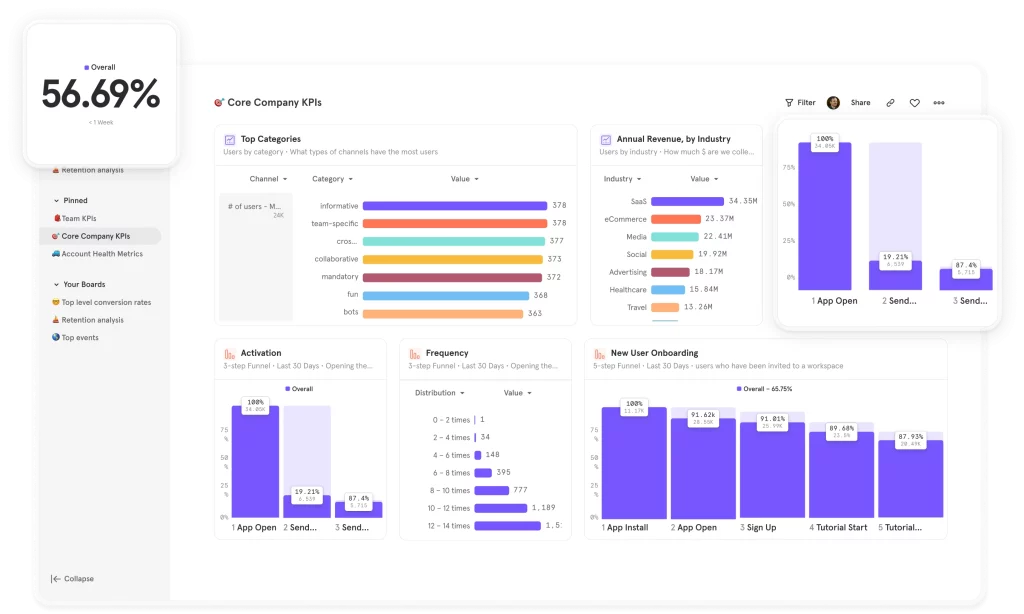
Why Mixpanel?
Mixpanel goes beyond simple pageview tracking by focusing on user actions and events. This makes it a powerful tool for product teams that need to track detailed user interactions and measure the impact of product changes.
Pros and Cons
| Pros | Cons |
|---|---|
| Advanced event-based tracking for detailed user insights | Can be complex for beginners to set up event tracking |
| In-depth funnel analysis and retention reports | Pricing can be steep for larger businesses |
| Real-time data with customizable reports | Requires significant setup to track custom events |
| Powerful segmentation and cohort analysis | Learning curve may deter small businesses |
Key Features
- Event tracking: Monitor user actions rather than just pageviews.
- Funnel analysis: Understand where users drop off in your product flow.
- Cohort analysis: Segment users based on behavior and engagement over time.
- Retention tracking: See how long users stick around and what keeps them coming back.
Mixpanel is ideal for companies looking to dive deep into user behavior and optimize their product features.
Kissmetrics
Kissmetrics is designed with conversion optimization in mind. It focuses on tracking individual visitor behavior over time, making it easier to pinpoint what drives conversions.
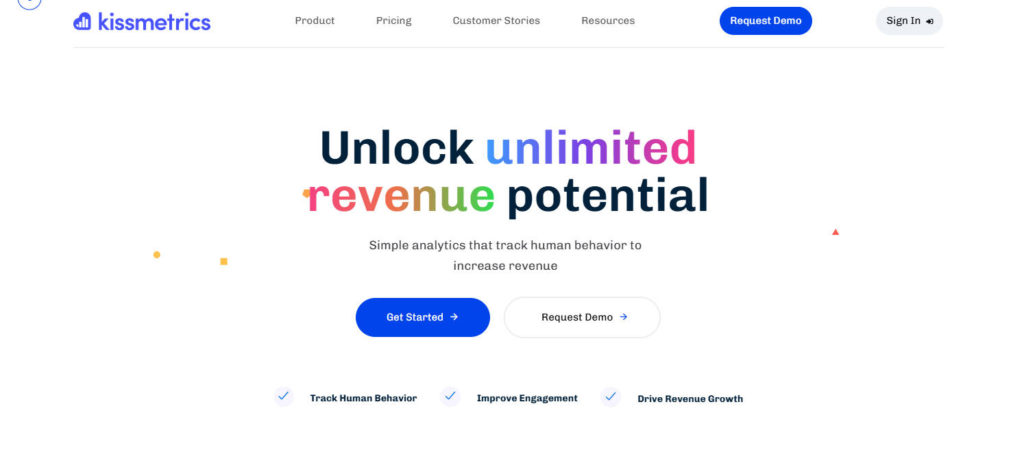
Why Kissmetrics?
Kissmetrics gives you a clear picture of your customer’s journey from first visit to conversion. Its detailed segmentation and funnel analysis make it a valuable tool for increasing ROI on your marketing efforts.
Pros and Cons
| Pros | Cons |
|---|---|
| Deep customer insights with detailed tracking per visitor | Higher cost compared to some entry-level analytics tools |
| Excellent funnel tracking and segmentation | Complex setup process may deter beginners |
| Actionable insights that drive conversion optimization | Limited real-time tracking capabilities |
| Focus on lifetime value and customer retention | Integration options can be more limited than larger platforms |
Key Features
- User-level tracking: Follow individual user journeys across multiple sessions.
- Conversion funnel analysis: Identify bottlenecks and optimize each step of your funnel.
- Customer segmentation: Break down your audience based on behavior, demographics, and more.
- Retention metrics: Track how long users remain engaged with your brand.
Kissmetrics is particularly well-suited for businesses focused on improving customer acquisition and retention through data-driven insights.
Heap Analytics
Heap Analytics automatically captures every user interaction, removing the need for manual event tagging. This “capture-all” approach is great for marketers and product teams who need comprehensive data without the hassle of configuring custom events.
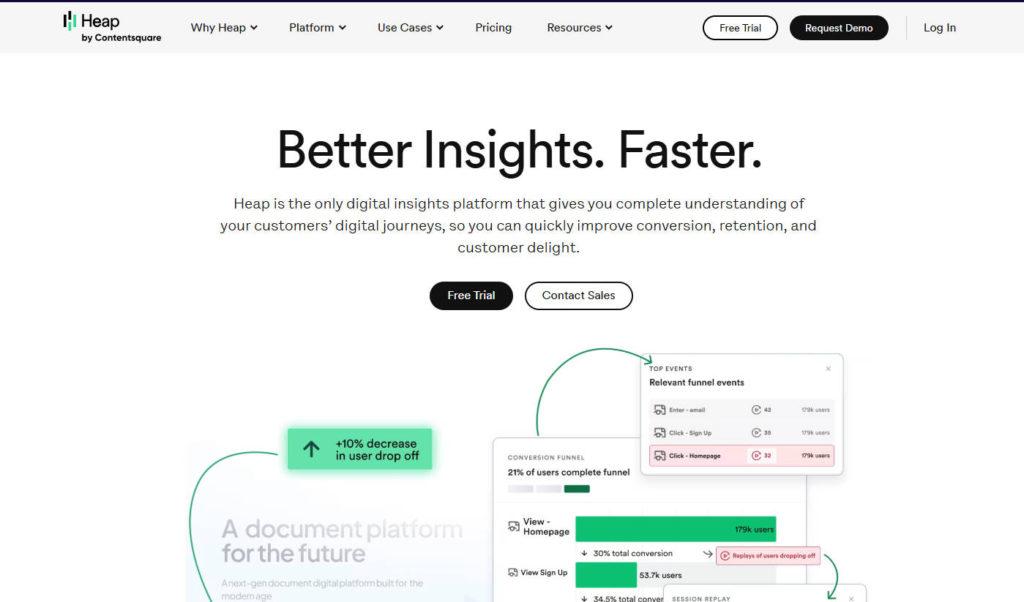
Why Heap Analytics?
Heap’s automatic data capture means you never miss an important user action. With minimal setup, Heap collects all interactions and lets you analyze the data retrospectively, making it a flexible tool for dynamic businesses.
Pros and Cons
| Pros | Cons |
|---|---|
| Automatic tracking of every user interaction | Can result in overwhelming data if not properly filtered |
| No need for manual event tagging | Customization options can be limited compared to manually tagged systems |
| Powerful retroactive analysis capabilities | Pricing may be a barrier for small businesses |
| Ideal for product teams needing comprehensive insights | Learning curve for effective data segmentation |
Key Features
- Automatic event capture: No need for manual tagging; Heap tracks everything.
- Retroactive analysis: Query historical data without prior setup.
- Custom dashboards: Build reports focused on the metrics that matter most to your business.
- User segmentation: Easily break down data by user attributes and behavior.
Heap Analytics is a game changer for teams that want to capture all user data without the overhead of manual configuration.
Woopra
Woopra is a customer journey analytics platform that connects real-time data with in-depth segmentation. It’s designed to give you a complete picture of your users from their first visit to long-term engagement.
Why Woopra?
Woopra offers real-time tracking combined with powerful segmentation, making it easier to understand the full customer journey. This helps businesses optimize not just for conversions but for long-term customer satisfaction.
Pros and Cons
| Pros | Cons |
|---|---|
| Real-time tracking with detailed user profiles | Can be complex to set up advanced segmentation |
| Comprehensive customer journey mapping | Pricing may be high for startups |
| Integration with multiple third-party tools | Learning curve for in-depth customization |
| Customizable dashboards and reports | May require technical expertise for full configuration |
Key Features
- Real-time analytics: Get instant insights into user behavior.
- Customer journey mapping: Visualize every step a user takes on your website.
- Advanced segmentation: Break down your audience into detailed cohorts.
- Cross-channel integration: Combine data from multiple sources for a unified view.
Woopra is a perfect fit for businesses that want to go beyond simple metrics and truly understand their customer journeys.
Statcounter
Statcounter offers simple yet effective website tracking with a focus on real-time data. It’s great for small businesses and bloggers who need essential insights without the overwhelming complexity.
Why Statcounter?
Statcounter provides a straightforward dashboard that covers the basics—real-time visitor tracking, popular pages, and referral information. It’s ideal for users who want clear insights without the bells and whistles.
Pros and Cons
| Pros | Cons |
|---|---|
| Simple and easy to use dashboard | Lacks advanced analytics features found in other tools |
| Real-time tracking of visitor data | Limited customization options |
| Affordable pricing plans for beginners | Not as feature-rich for large enterprises |
| Quick insights without the complexity | Basic reporting that may not suit advanced users |
Key Features
- Live visitor tracking: Monitor visitors in real time.
- Referrer analysis: Understand where your traffic is coming from.
- Popular pages and paths: Identify which pages are most engaging.
- Simple reports: Get the essential data you need without overwhelming detail.
Statcounter is a solid option for those who want a no-fuss, budget-friendly analytics solution.
Piwik PRO
Piwik PRO is a privacy-focused analytics suite designed for businesses that require stringent data protection and compliance with global privacy standards like GDPR and HIPAA.
Why Piwik PRO?
Piwik PRO offers enterprise-grade analytics with full control over your data. It’s an excellent choice for businesses in regulated industries that demand robust privacy and security features.
Pros and Cons
| Pros | Cons |
|---|---|
| Strong privacy and data protection compliance | Can be costly for small businesses |
| Enterprise-grade analytics with full data control | Interface might be less intuitive compared to consumer tools |
| Comprehensive reporting and segmentation | Setup can be more technical and complex |
| Customizable dashboards to meet unique business needs | Fewer third-party integrations than mainstream tools |
Key Features
- Privacy-first analytics: Ensure data compliance with global regulations.
- Custom reporting: Tailor dashboards and reports to your organization’s needs.
- Visitor segmentation: Deep segmentation for detailed insights.
- Full data ownership: Host your analytics data on your own servers if needed.
Piwik PRO is the go-to tool for enterprises and privacy-conscious businesses.
Open Web Analytics
Open Web Analytics (OWA) is another open-source alternative that provides robust tracking capabilities similar to Google Analytics—but with full data ownership. It’s ideal for developers and small businesses wanting a free, customizable solution.
Why Open Web Analytics?
OWA offers an open-source platform that allows you to track user behavior and website performance without vendor lock-in. It’s highly customizable and a great option for businesses with technical expertise.
Pros and Cons
| Pros | Cons |
|---|---|
| Free and open-source with complete data ownership | Setup and maintenance require technical knowledge |
| Customizable tracking and reporting | Interface can be less modern and user-friendly |
| No vendor lock-in | Limited support and community resources compared to commercial tools |
| Offers many features similar to Google Analytics | Not ideal for businesses with very high traffic volumes |
Key Features
- Self-hosted analytics: Keep full control of your data on your own servers.
- Customizable dashboards: Tailor reports to meet your business needs.
- Visitor tracking: Monitor user behavior with detailed metrics.
- Event tracking: Set up custom events to capture specific interactions.
Open Web Analytics is best for those who want complete control and are comfortable with a more hands-on setup.
GoSquared
GoSquared is a modern website analytics platform that focuses on simplicity and real-time data. It’s designed for businesses that need actionable insights quickly, with an emphasis on customer engagement.
Why GoSquared?
GoSquared offers an attractive and easy-to-use dashboard that provides real-time data, customer profiles, and engagement metrics. It’s perfect for businesses that want to combine analytics with a bit of CRM functionality.
Pros and Cons
| Pros | Cons |
|---|---|
| Real-time analytics with an intuitive dashboard | Can be expensive as your traffic scales |
| Integrates analytics with customer engagement tools | Limited advanced segmentation compared to specialized tools |
| Easy setup and beautiful design | Some features may be too basic for enterprise-level needs |
| Great customer support and onboarding | Fewer customization options than more advanced platforms |
Key Features
- Real-time visitor tracking: See live visitor data and engagement.
- Customer profiles: Combine analytics with CRM-like insights.
- Actionable reports: Quickly identify trends and opportunities.
- Integrations: Connect with other marketing tools for a seamless workflow.
GoSquared is an excellent solution for businesses that want a blend of analytics and customer engagement in a beautifully designed platform.
Conclusion
Choosing the right website tracking tool is essential for your business’s growth and conversion optimization. From the comprehensive, conversion-focused power of Visitor Tracking to the industry-standard insights from Google Analytics and the enterprise-level features of Adobe Analytics, there’s a tool here for every need and budget.
Each of these 15 tools offers its own unique blend of features:
- Visitor Tracking shines with its simplicity, speed, and laser focus on conversions.
- Google Analytics provides an industry-standard free solution with deep integrations.
- Adobe Analytics caters to large enterprises with its advanced segmentation.
- Matomo and Open Web Analytics offer full data control and privacy.
- Clicky, Hotjar, and Crazy Egg bring real-time and visual insights that drive quick improvements.
- Mixpanel, Kissmetrics, and Heap Analytics are built for detailed user behavior tracking and event-based analysis.
- Woopra, Statcounter, Piwik PRO, and GoSquared round out the list with specialized features for customer journey mapping, privacy compliance, and modern real-time insights.
No matter your business size or industry, tracking your website’s performance with the right tool can unlock new opportunities for growth, optimization, and revenue. Remember, the key is not just to gather data, but to turn that data into actionable insights that drive conversions and improve the overall user experience.
If you’re looking for a tool that can offer a 30-second setup, real-time analytics, and a focus on boosting your conversion rates, then Visitor Tracking is the clear winner. Its user-friendly interface, robust feature set, and proven performance make it the ultimate choice for online businesses serious about growth.
Final Thoughts
Website tracking is more than just counting clicks—it’s about understanding the journey your visitors take, pinpointing exactly where you can improve, and leveraging data to make smarter marketing decisions. Whether you opt for a tool that emphasizes visual insights like Hotjar and Crazy Egg or go for a powerhouse like Adobe Analytics, remember that the best tool is the one that aligns with your business goals and technical capacity.
Now that you have a detailed overview of the top 15 website tracking tools, it’s time to choose the one that best suits your needs. Dive into the demos, explore the features, and start turning your website data into actionable insights that drive revenue and growth.
Happy tracking, and here’s to your next breakthrough in conversion optimization!


